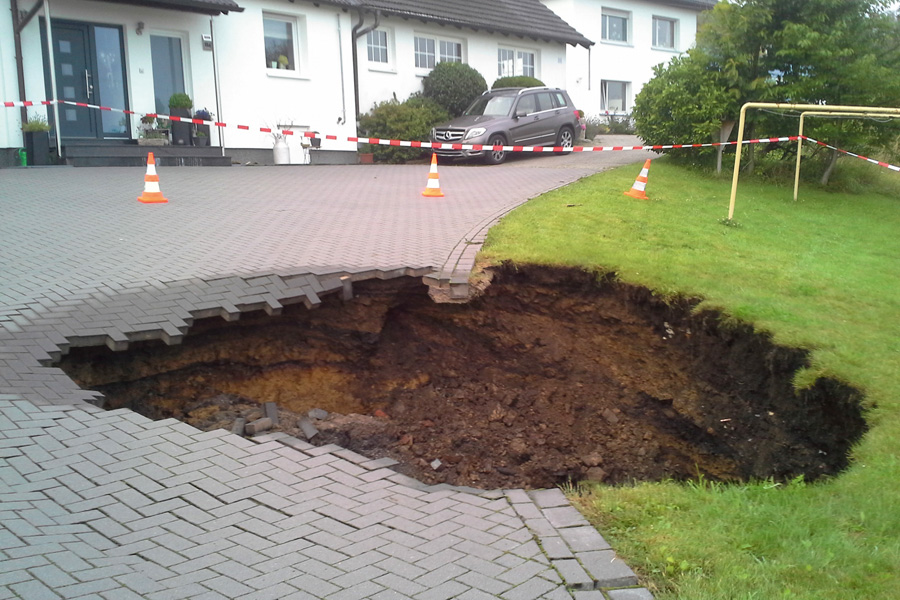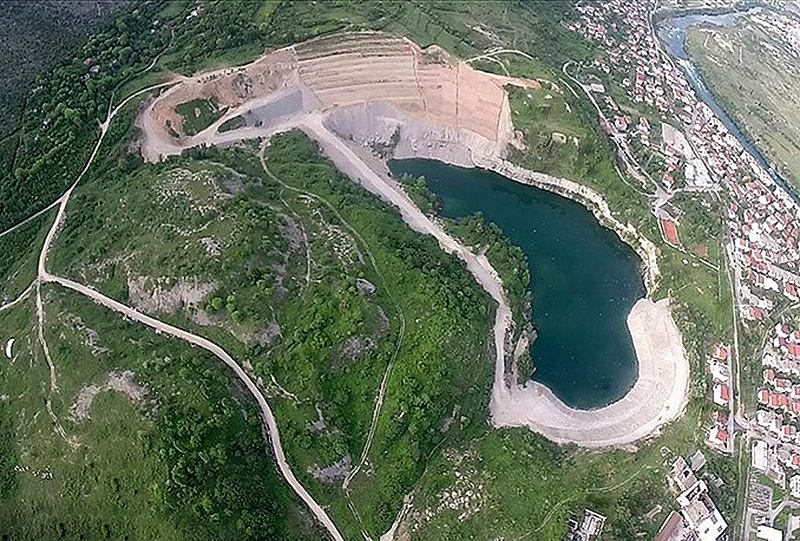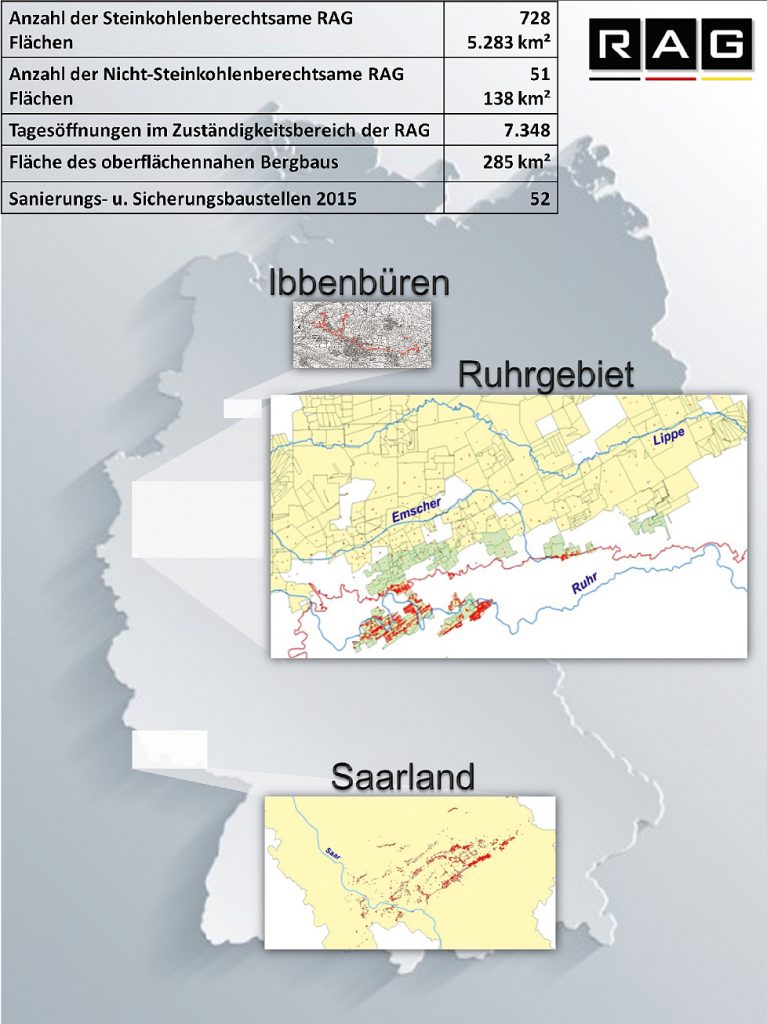Germany can look back on a long mining tradition and the economic development of the country is very much tied in with the mining industry. Mining was the motor that drove reconstruction after the Second World War and it has remained an important foundation upon which our current prosperity is based. Germany has been extracting natural resources over many generations, including coal, lignite, potash, rock salt, metal ores and quarry materials, not to mention oil and gas. But the grim reality is that mining always has an impact on the natural environment and …
Read moreWith my best regards // Mit freundlichem Glückauf
Dipl.-Ing. Andreas-Peter Sitte
Chief Editor Mining Report Glückauf, Herne
The NRW Mines Inspectorate Approach to the Hazards Posed by Abandoned Mines

Fig. 2. Surface collapse at Witten, Speckbahn 15, in 2015. // Bild 2. Tagesbruch in Witten, Speckbahn 15, im Jahr 2015.
Authors: Abteilungsdirektor Friedrich Wilhelm Wagner, Leiter der Abteilung Bergbau und Energie in NRW, Leitender Bergvermessungsdirektor Andreas Welz, Leiter des Dezernats Altbergbau und Bergdirektor Ulrich Hoppe, Dezernent im Sachgebiet Markscheiderische Aufgaben im Altbergbau bei der Bezirksregierung Arnsberg, Dortmund
Read moreElements and Aspects of the Post-Mining Era
The subsidised German coal industry will cease to exist on 31.12.2018. The post-mining era will then set in, not just in the coalfields of North Rhine-Westphalia and Saarland, but in many other German mining regions too, where it has already been a reality for some time. The elements and aspects of the post-mining age will mean a permanent weighing-up of opportunities and risks, and this is a task that will also face coming generations. The post-mining era will be a time for risk prevention, restoration and the re-development of former mining sites. Two of the key challenges will be to protect and secure surface structures and to manage mine-water flow. Specially developed monitoring systems will play a vital role here, while in terms of land recycling and conversion the focus will be on drawing up plans for attracting and establishing new businesses, developing renewable-energy production facilities, ecological upgrading and promoting tourism and cultural attractions.Authors: rof. Dr. rer. nat. Christian Melchers und Prof. Dr.-Ing. Peter Goerke-Mallet, Forschungszentrum Nachbergbau der Technischen Hochschule Georg Agricola (THGA), Dipl.-Ing. Karl Kleineberg, DMT Gesellschaft für Lehre und Bildung mbH, Bochum
Read moreMine Surveying and Post-Mining Activities of RAG Aktiengesellschaft
RAGAktiengesellschaft, Herne/Germany, owns the last two coal mines in Germany: the mine Prosper-Haniel in Bottrop and the Mine in Ibbenbüren. At the end of 2018 the production of hard coal will be finished. But even then the RAG Aktiengesellschaft remains responsible for the consequences caused by the coal industry. The area of responsibility will include settling of mining damage and the handling of closed mines among others. RAG Aktiengesellschaft is intensively dealing with this matter, bears the responsibility and takes action. This article demonstrates how the risks of historical mine building and former surface openings are consequently met in the post-mining sector. The majority of these risks date from long before the foundation of RAG Aktiengesellschaft. Important elements are a well-functioning risk management system, an optimized monitoring system and preventive exploration and remediation measures which are state of the art.Authors: Dipl.-Ing. Stefan Hager, Leiter Servicebereich Standort- und Geodienste, und Dipl.-Ing. Frank Wollnik, Abteilungsleiter Altbergbau/markscheiderische Bearbeitung im Servicebereich Standort- und Geodienste der RAG Aktiengesellschaft, Herne
Read moreResidual Lakes in the Rhineland Lignite Area
The lignite mining area of the Rhineland/Germany is bounded by the three cities of Dusseldorf, Cologne and Aachen. Lignite has been mined in this locality since the 18th century and the three opencast mines currently in operation, namely Inden, Hambach and Garzweiler, produce between 90 and 100 mt of fuel a year. About 85 % of the annual production is used for electricity generation, with the remaining 15 % being delivered to processing plants. The following paper sums up the authorisation and approval status of Rhineland’s three remaining opencast lignite mines in terms of their future land-use and development.Author: A.d.B. Jasmin Korbmacher M.Sc. , Dezernat Rohstoffe im Tagebau in der Abteilung für Bergbau und Energie in NRW der Bezirksregierung Arnsberg, Dortmund
Read moreInvestigation, Securing and Remediation of the Former Coal Mine Vihovići in Mostar, Bosnia-Herzegovina

Fig. 11. Aerial view on the remaining pit Vihovići (06/2015). // Bild 11. Luftbildaufnahme Tagebaurestloch Vihovići (06/2015).
Authors: Dipl.-Geol. Michael Mackenbach, Dipl.-Geol. Nikolaus Linder, Abteilung Mining & Environment der Fichtner Water & Transportation GmbH, Essen
Read moreThe Project “Sustainable Site Development of the Mining Region Erdenet, Mongolia”
The project “Sustainable site development of the mining region Erdenet, Mongolia” was commenced in spring, 2014 by the partners and project sponsors the government of the province of Orkhon and mayor of the city of Erdenet, the management of the Erdenet Mining Corporation (EMC) and the management of the Berlin-based mining consulting company geotec Rohstoffe GmbH.The overall objective of the project is defined as follows: Development and implementation of a program of measures for the ecological rehabilitation and economic re-valorization of the mining region Erdenet. From the very beginning the guiding principle was to develop the project “Sustainable site development of the mining region Erdenet, Mongolia” as a pilot project for Mongolia as well as to develop the project under the bilateral cooperation between Germany and Mongolia.
Authors: Dr. rer. nat. Rüdiger Schwarz, Geschäftsführer, Dennis Bastian M. Sc., Explorationsgeologe, und Rebecca Reiche B. Sc., Projektmanagerin geotec Rohstoffe GmbH, Berlin
Read moreThe German Lignite Industry in 2015
Germany’s domestic lignite output decreased by 0.1 % from 178.2 mt to 178.1 mt between 2014 and 2015. 2015’s extracted lignite had a net calorific value of 54.9 mtce. 159.3 mt, or almost 90 %, of that output were used in utility power plants supplying the general public. This translates into an increase of 0.2 % compared to the previous year. 14.9 mt were used in the factories of the lignite mining industry for the manufacture of solid products. 2.0 mt were used to generate electricity in mine-mouth power plants. 1.9 mt accounted for other sales of raw lignite and changes in stocks. Lignite’s contribution to Germany’s total electricity production amounted to 23.8 % in 2015.Authors: Dipl.-Volkswirt Uwe Maaßen, Geschäftsführer Statistik der Kohlenwirtschaft e. V., Köln, und Dr. rer. pol. Hans-Wilhelm Schiffer, Executive Chair World Energy Resources, World Energy Council, London
Read more















